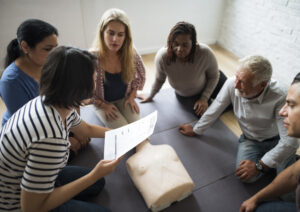Introduction
In times of emergency, the capability to carry out Cardiopulmonary Resuscitation (MOUTH-TO-MOUTH RESUSCITATION) can be the distinction in between life and fatality. In Australia, understanding the CPR qualification requirements is vital for anybody wanting to become a licensed rescuer. This thorough overview will explore what you need to know about CPR accreditation in Australia, including training options, validity of certifications, age-specific guidelines, and more.
CPR Accreditation Demands in Australia: What You Need to Know
What is CPR?
Cardiopulmonary Resuscitation (MOUTH-TO-MOUTH RESUSCITATION) is an emergency situation procedure done when somebody's heart stops beating or they stop taking a breath. It incorporates upper body compressions with rescue breaths to keep blood circulation and oxygenation until specialist clinical help arrives.
Why is mouth-to-mouth resuscitation Important?
The vital value of mouth-to-mouth resuscitation can not be overstated-- it saves lives. According to statistics from the Australian Resuscitation Council, prompt mouth-to-mouth resuscitation can double or triple a victim's possibility of survival after heart attack.
Understanding CPR Certification
To become accredited in mouth-to-mouth resuscitation, individuals must undergo training with recognized organizations. Qualifications generally include hands-on abilities practice and theoretical knowledge regarding cardiac emergencies.
Types of CPR Educating Available
Basic Life Assistance (BLS) vs. Advanced Life Support (ALS)
- Basic Life Support (BLS) concentrates on essential strategies including breast compressions and rescue breaths. Advanced Life Support (ALS) covers extra complicated procedures such as advanced airway monitoring and medication administration.
Online vs. In-Person Training
- Online mouth-to-mouth resuscitation certification deals flexibility yet may lack hands-on experience. In-person classes give useful abilities method essential for effective action in emergencies.
CPR Qualification Process
Choosing an Educating Provider
When seeking training, make certain that your selected provider is approved by trusted organizations like the Australian Resuscitation Council or St John Ambulance.
Course Period and Content
Most standard training courses last about 4 hours and cover:
- Adult CPR techniques Use of Automated External Defibrillators (AED) Recognition of heart attack signs
CPR Certification Validity
How Long Does a CPR Certification Last?
Typically, a mouth-to-mouth resuscitation certification continues to be legitimate for three years before needing revival. It is vital to remain updated with the current protocols and guidelines.
Renewing Your Certification
Renewal frequently includes taking a refresher course that reviews crucial abilities and updates guests on any kind of adjustments in guidelines.
Age-Specific mouth-to-mouth resuscitation Guidelines Australia
Adult vs. Child vs. Infant mouth-to-mouth resuscitation Techniques
Different age need customized methods:
- For grownups, focus on compression depth and rate. For children, readjust compression depth based upon size. Infant CPR technique includes mild compressions and careful ventilation.
Infographic: Age-Specific Techniques
|Age|Compression Deepness|Proportion|| -----------|-------------------|-------|| Grownups|5-6 centimeters|30:2|| Kids|4-5 centimeters|30:2|| Babies|1.5 cm|30:2|
CPR Equipment in Australia
Essential Equipment for Reliable Response
Having access to appropriate CPR equipment aids successful resuscitation initiatives:
AEDs Pocket masks Gloves
Using AED with mouth-to-mouth resuscitation in Australia
An Automated External Defibrillator can significantly raise survival rates when used together with CPR-- recognizing just how to use an AED successfully is https://cpr.com.au/location/wa/first-aid-course-perth/ important for every single rescuer.
Common Myths Regarding CPR
The Misconception of "Mouth-to-mouth Resuscitation Always Restarts Heart"
Many believe that executing CPR will certainly always reactivate a heart; nonetheless, this is misleading-- mouth-to-mouth resuscitation keeps blood flow till professional aid arrives cpr.com.au but does not guarantee revival.
Debunking Other Misconceptions
Other misconceptions consist of misunderstanding compression deepness or the effectiveness of rescue breaths versus hands-only techniques; education and learning plays a crucial role in dispelling these falsehoods.

Special Circumstances in Doing CPR
CPR for Drowning Victims
Drowning sufferers usually need instant rescue breaths as a result of their distinct conditions; understanding this context improves end results significantly.
Sports-Related Cardiac Arrest Procedures
Recognizing indications particular to athletes aids responders act quickly-- education pertaining to sports-related heart events is crucial for coaches and trainers alike.
Workplace Emergency situation Plans
Establishing Readiness at Workplaces
Every office should have a comprehensive emergency situation plan that includes stipulation for emergency treatment training like cpr and first aid combo courses for employees.
Training Workers Effectively
Regular training sessions make sure personnel are prepared-- not only does this shield workers yet also boosts overall work environment safety and security culture.
Frequently Asked Inquiries (Frequently asked questions)
Q1: How do I locate local mouth-to-mouth resuscitation classes?
A1: Neighborhood recreation center or medical facilities usually offer classes; sites of companies like St John Ambulance offer listings as well.
Q2: Can I obtain my accreditation online?
A2: Yes! Several accredited companies use online mouth-to-mouth resuscitation certification, however guarantee it consists of hands-on practice aspects as well.
Q3: Is there a difference in between grown-up and youngster certifications?

Q4: Exactly how frequently should I renew my certification?
A4: Typically every 3 years; nevertheless, staying upgraded annually with refresher courses is highly suggested offered advancing guidelines.
Q5: Exist any type of details legislations relating to mandatory training?
A5: While laws may differ by state or region, several offices are needed by legislation to have educated initial -responders available on-site throughout functioning hours.
Q6: What stats support the efficiency of CPR?
A6: Researches show that prompt bystander-administered CPR can increase survival prices from cardiac arrest considerably-- often increasing opportunities of client healing contrasted to no intervention at all.

Conclusion
Understanding the details of the CPR qualification needs in Australia encourages people across numerous industries-- from medical care specialists to daily residents-- to act emphatically throughout emergency situations. With appropriate training, recognition of age-specific guidelines, knowledge about devices such as AEDs, and experience with usual misconceptions bordering resuscitation efforts, one can absolutely make a distinction when it matters most. Whether you're thinking about registering in regional classes or checking out on the internet alternatives like online cpr certification, keep in mind that each step taken towards ending up being qualified contributes toward conserving lives-- an honorable search indeed!